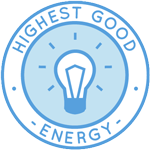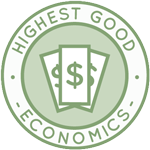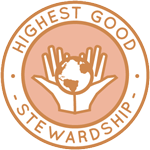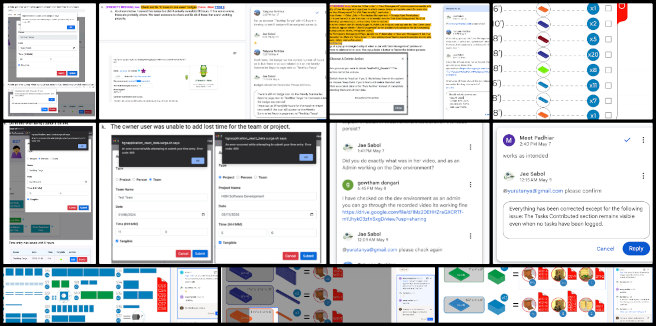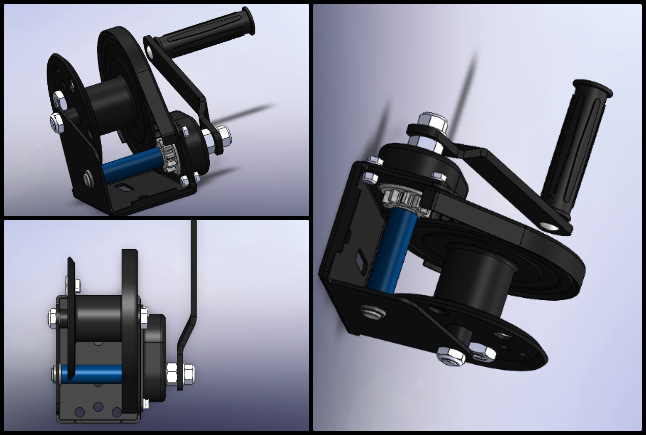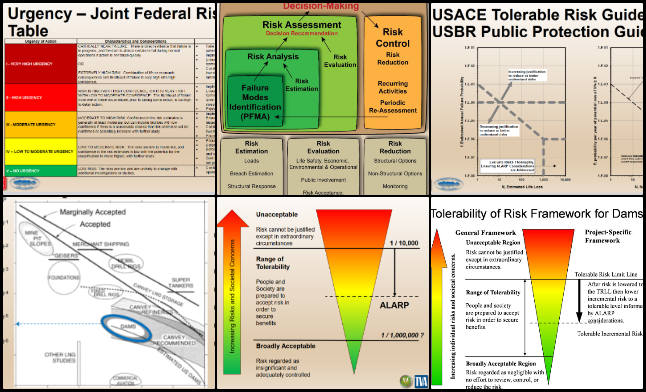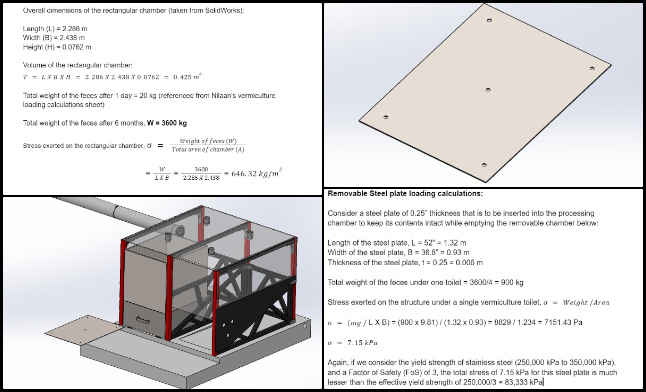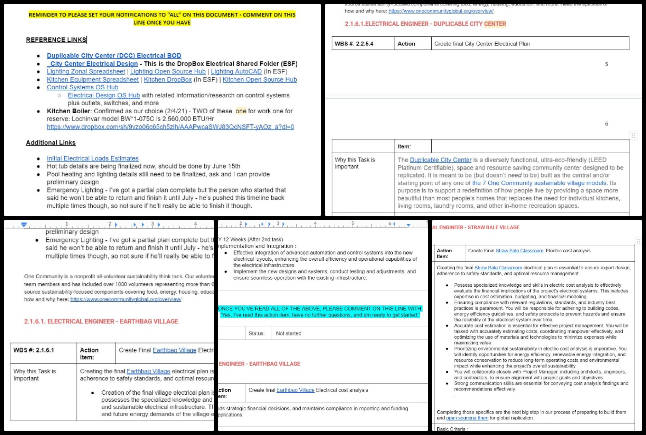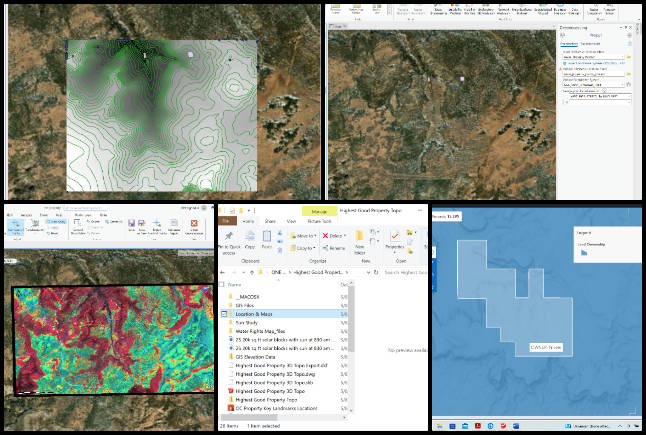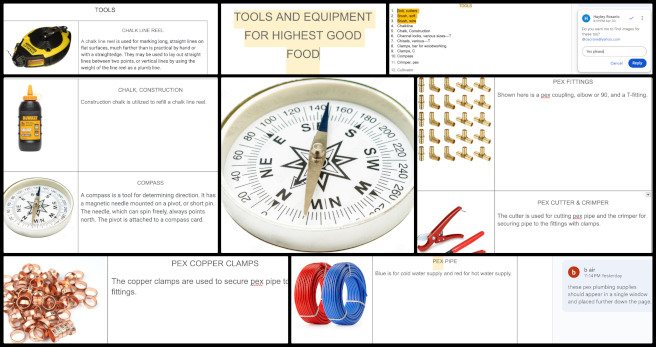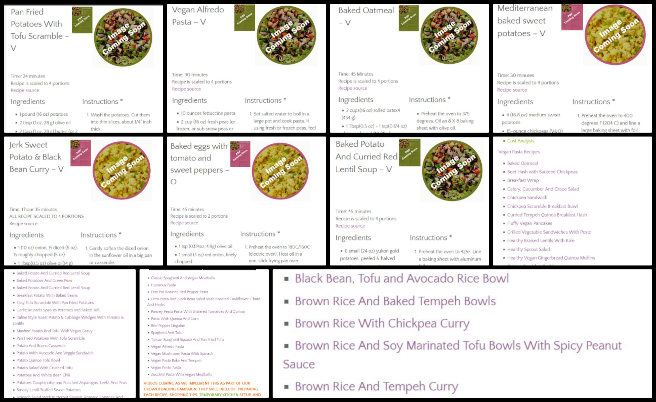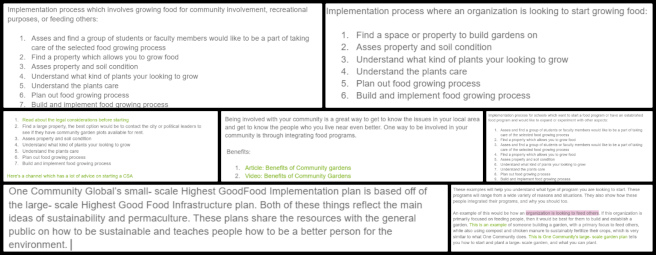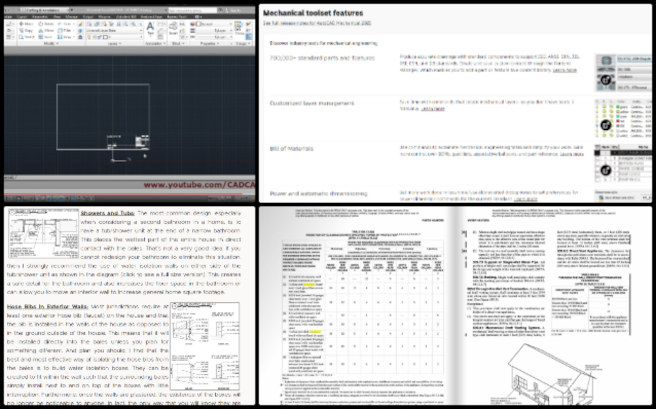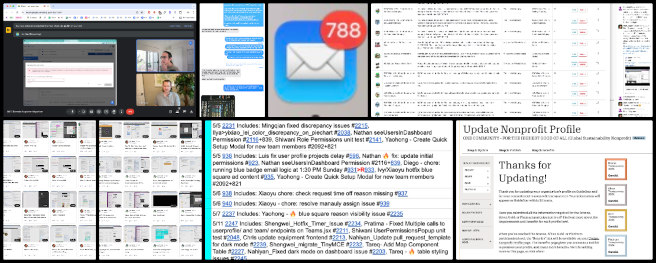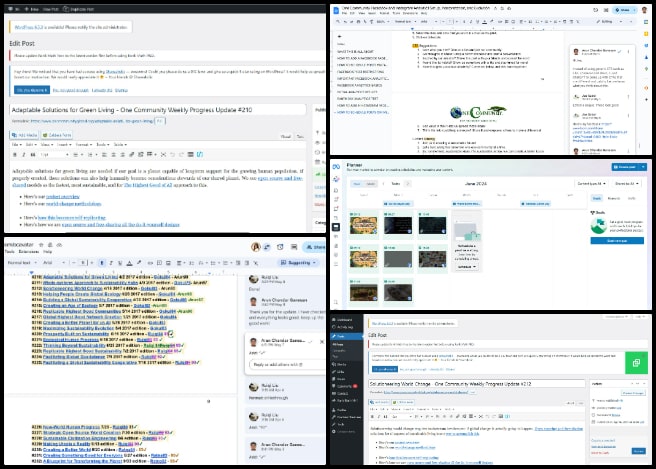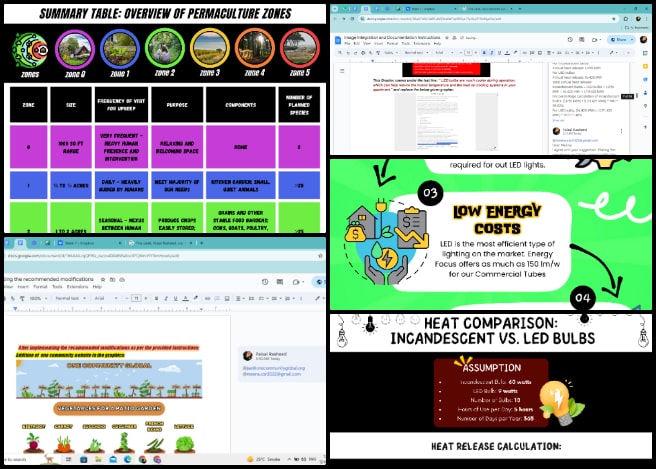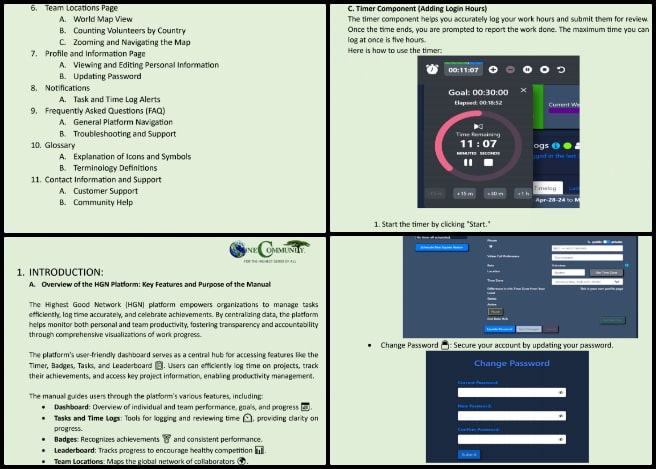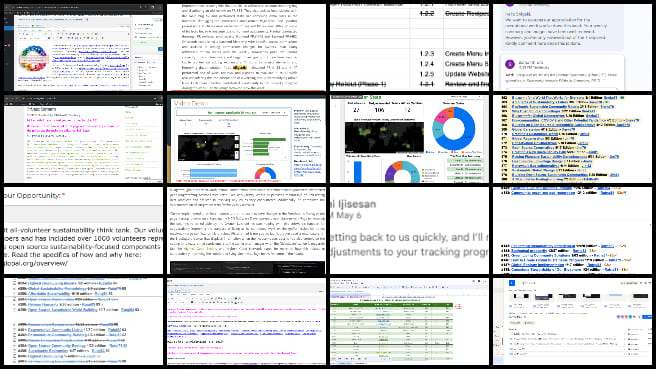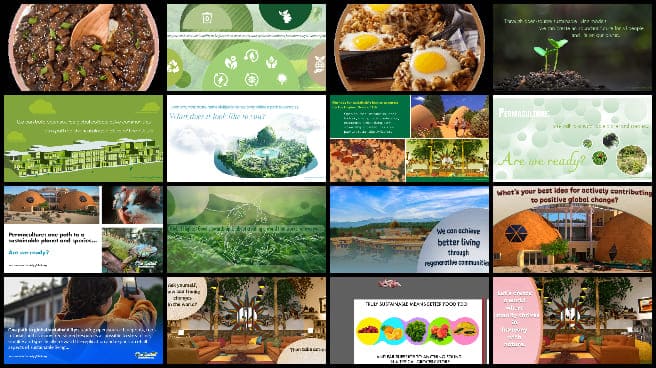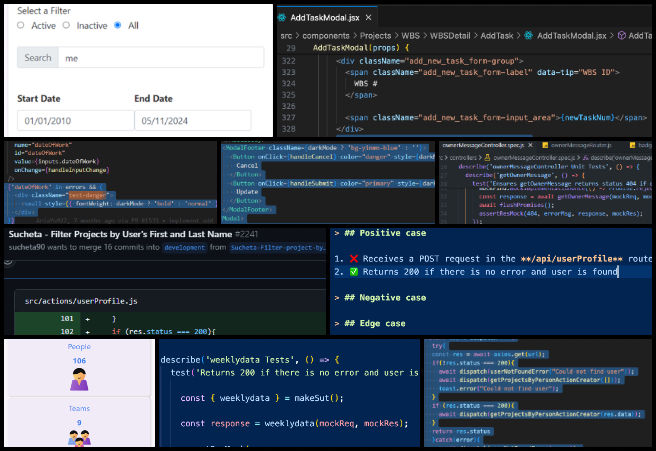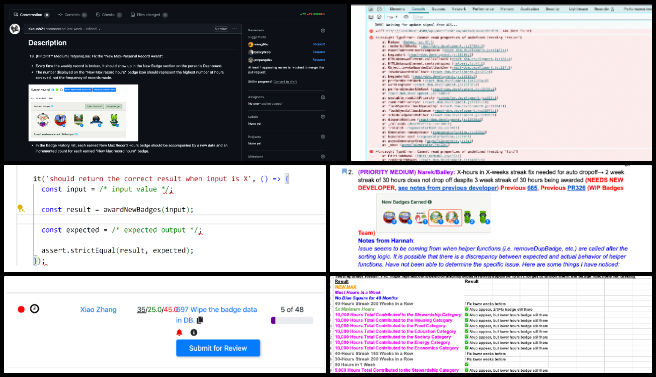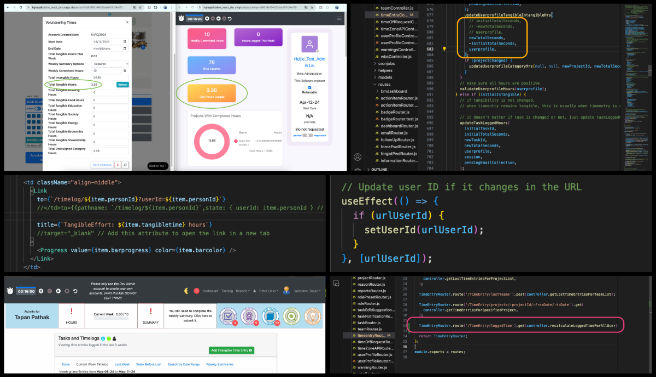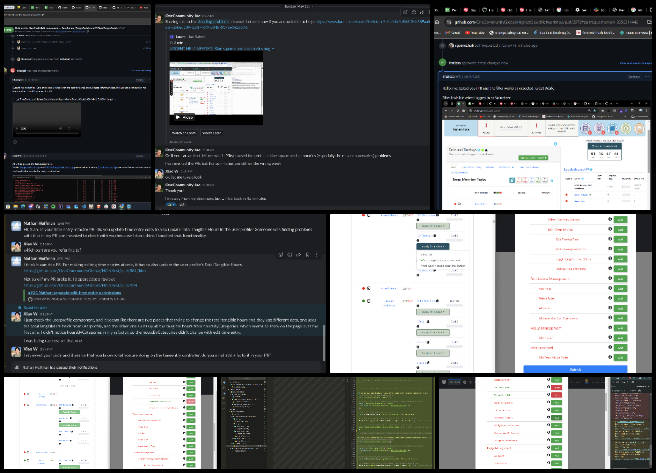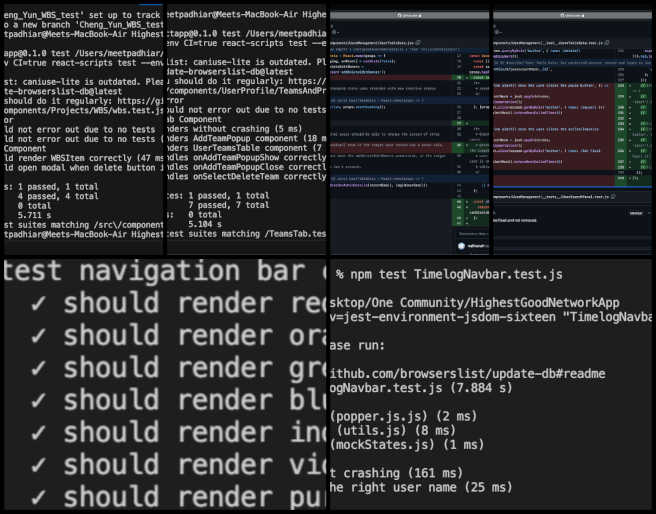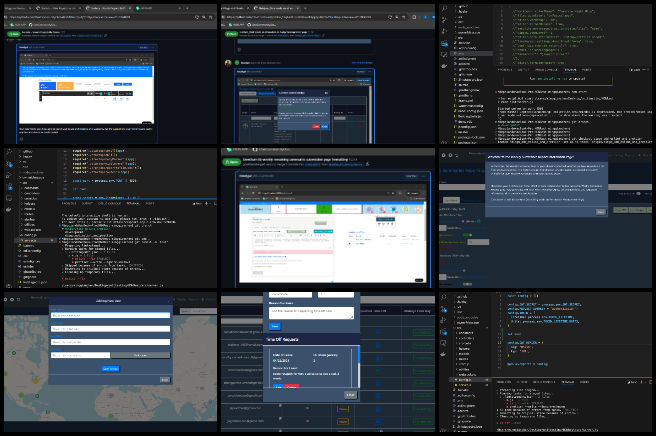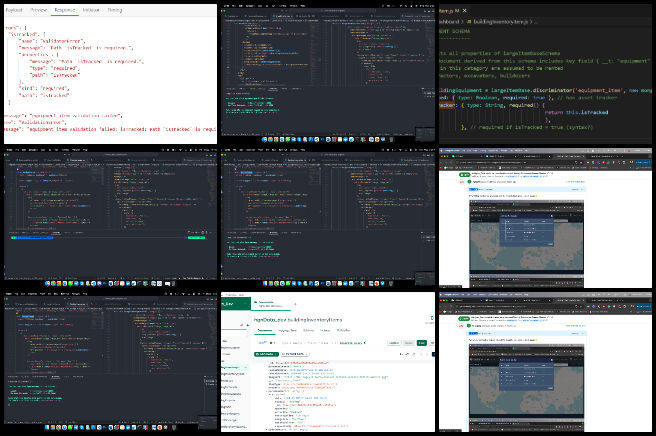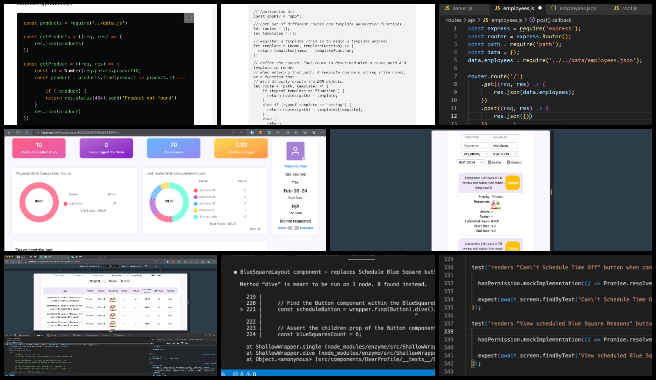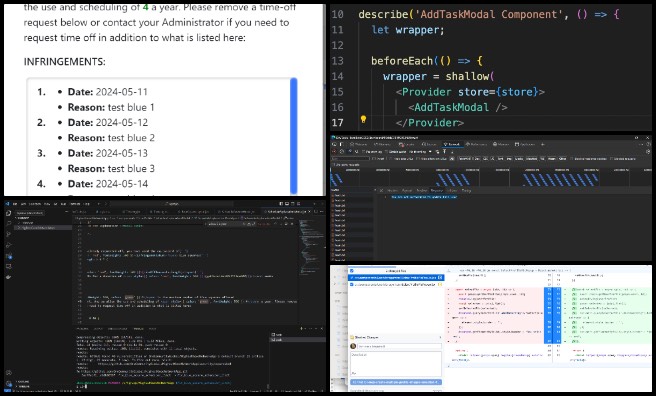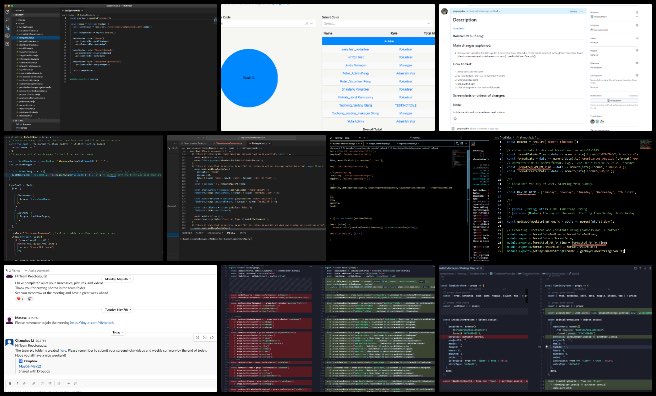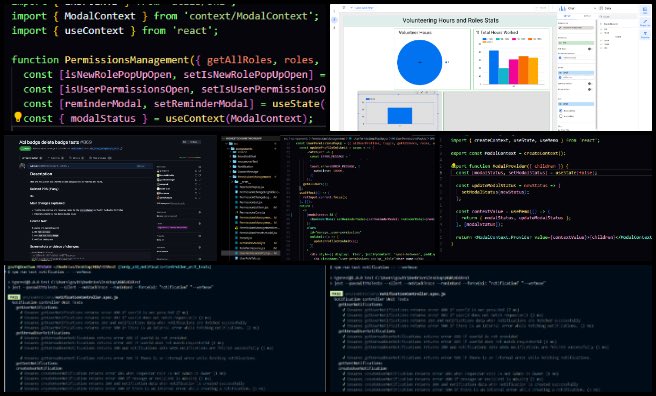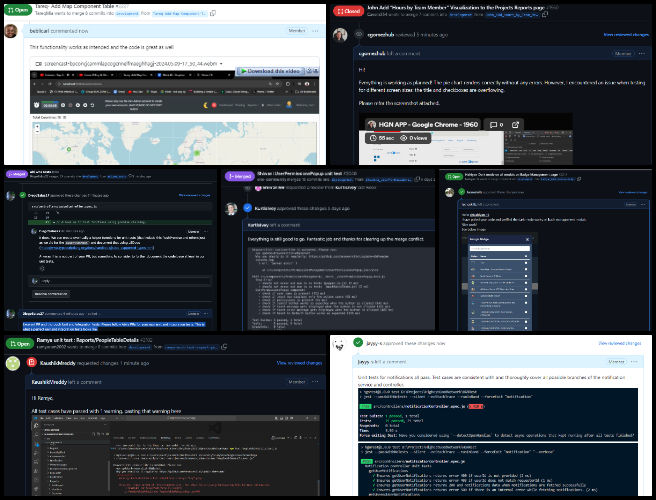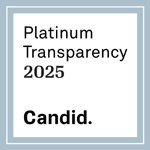Sustainable and Free-shared Ecology – One Community Weekly Progress Update #582
Developing sustainable and free-shared ecology for a better world is a top priority for One Community. As an all-volunteer organization, we’re pioneering sustainable approaches to food, energy, housing, education, economics, and social architecture. Our model is designed to become self-replicating, establishing a global collaboration of teacher/demonstration hubs. We’re driven by the principle of doing this for “The Highest Good of All” ensuring that everything we create is open source and free-shared. Join us in our mission to evolve sustainability, regenerate our planet, and create a world that works for everyone.
- Here’s our project overview
- Here’s our world-change methodology
- Here’s how this becomes self-replicating
- Here’s how we are open source and free-sharing all the do-it-yourself designs
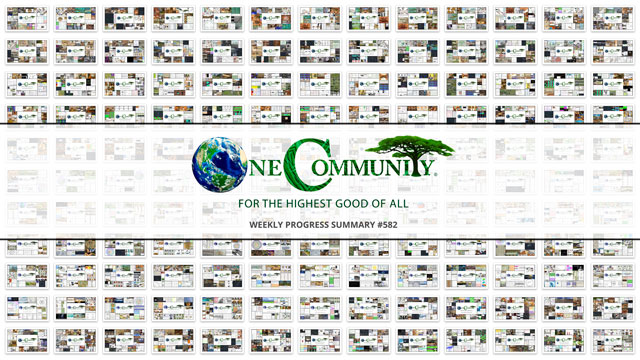
OUR MAIN OPEN SOURCE HUBS
Click on each icon to be taken to the corresponding Highest Good hub page.
One Community’s physical location will forward this movement of sustainable and free-shared ecology as the first of many self-replicating teacher/demonstration communities, villages, and cities to be built around the world. This is the May 13th, 2024 edition (#582) of our weekly progress update detailing our team’s development and accomplishments:
Sustainable and Free-shared Ecology
One Community Progress Update #582
DONATE | COLLABORATE | HELP WITH LARGE-SCALE FUNDING
CLICK HERE IF YOU’D LIKE TO RECEIVE AN EMAIL EACH WEEK WHEN WE RELEASE A NEW UPDATE
YOU CAN ALSO JOIN US THROUGH SOCIAL MEDIA
ONE COMMUNITY WEEKLY UPDATE DETAILS
HIGHEST GOOD HOUSING PROGRESS
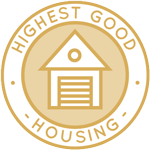 One Community is developing sustainable and free-shared ecology through Highest Good housing that is artistic and beautiful, more affordable, more space efficient, lasts longer, DIY buildable, and constructed with healthy and sustainable materials:
One Community is developing sustainable and free-shared ecology through Highest Good housing that is artistic and beautiful, more affordable, more space efficient, lasts longer, DIY buildable, and constructed with healthy and sustainable materials:
- Learn about: Our Upcoming Crowdfunding Campaign
- Learn about the different sustainable and free-shared ecology village models: 7 Sustainable Village Models
- Visit the open source portals for the first two: Earthbag Village OS Hub | Straw Bale Village OS Hub
This week, the core team reviewed the final version of the Murphy Bed Assembly instruction document, checking, confirming, and resolving eight comments. They also continued their work on the Highest Good Network PRs testing, confirming the fixed PRs. They addressed issues such as user visibility on the dashboard, mouseover text corrections, weekly summaries editing errors, discrepancies in color display and tested for issues related to user permissions and dashboard functionality. However, there were unresolved issues with PRs related to the absence of a badge icon on the Weekly Summaries Reports page, problems with the Lost Time function, and the appearance of the Tasks Contributed section in the People Report. See the Highest Good Society and Highest Good Network pages for more on how this relates to sustainable and free-shared ecology. The collage below shows some of their work.
Joseph Osayande (Mechanical Engineer) began helping to finish the Vermiculture Toilet designs. He researched three methods for removing an inserted block from a container used to segregate process waste, comparing ratchet, pulley, and winch systems. After evaluating the options, it was determined that the winch system offers superior advantages due to its precise control over the extraction process, ensuring safe and efficient removal of the fitted item from the confined space. A winch prototype was then designed using SolidWorks to address the problem, intended to handle appropriate loads for extraction. Additionally, research was done on the optimal materials for housing the winch. The vermiculture toilets and other sustainable human waste processing technologies form the basis of One Community’s open source sustainable and free-shared ecology model. See below for some of the pictures related to this work.
Loza Ayehutsega (Civil Engineer/Assistant Civil Engineer) completed another week working on the Earth Dam risk assessment and dam break hazard assessment. She particularly worked on tolerable dam risk assessment and is also working on Emergency Action Plans. However, it is also recommended to add additional content about risk assessment. A tolerable dam risk assessment aims to evaluate and manage these risks within acceptable limits determined through a combination of engineering judgment, regulatory standards, historical data, and societal expectations. Ensuring dam safety measures and preparedness are a foundation of One Community’s open source earthworks as part of the sustainable and free-shared ecology model. See the pictures below for examples related to this work.
Rizwan Syed (Mechanical Engineer) also continued helping to finish the Vermiculture Toilet designs. He focused on iterating the design concept for the processing and removable chambers of One Community’s vermiculture eco-toilets. He explored options to remove the small lip portion beneath the removable slot to achieve a continuous interface between the two stacked chambers that collect waste material. Additionally, Rizwan adjusted the size of the two components and modified their construction material from wood to steel to enhance durability. To ensure the design’s feasibility, he performed hand calculations for stress and loading to determine the maximum load that the vermiculture chamber could support over a six-month period. The vermiculture toilets and other sustainable human waste processing technologies form the basis of One Community’s open source sustainable and free-shared ecology model. Here are a few photos showing examples of his work.
Sajal Shah (Project Manager) continued managing completion of the Highest Good Energy components. organized files for electrical design collaboration, cataloging necessary links for future reference. She worked on compiling detailed descriptions and Work Breakdown Structures (WBS) for various positions involved in the project. The Highest Good Energy is an essential component of One Community’s open source model for sustainable and free-shared ecology. See below for some of the pictures related to this work.
DUPLICABLE CITY CENTER PROGRESS
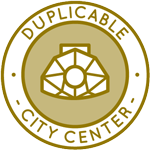 One Community is developing sustainable and free-shared ecology through a Duplicable and Sustainable City Center that is LEED Platinum certified/Sustainable, can feed 200 people at a time, provide laundry for over 300 people, is beautiful, spacious, and saves resources, money, and space:
One Community is developing sustainable and free-shared ecology through a Duplicable and Sustainable City Center that is LEED Platinum certified/Sustainable, can feed 200 people at a time, provide laundry for over 300 people, is beautiful, spacious, and saves resources, money, and space:
- Learn about this building and its function as part of sustainable and free-shared ecology: Duplicable City Center Open Source Hub
This week, Chris Blair (GIS Technician/Horticulturist) began working with GIS data as part of One Community’s Permaculture Design. He downloaded previous GIS work by Ben Missimer and imported data into ArcGIS Pro, ensuring consistency by transforming geographic coordinate systems to NAD 1983. Additionally, he georeferenced images by matching identifiable features in both base maps and images. Chris imported the master plan and initiated a review of its compatibility with provided geospatial data, alongside researching property details via government websites. Proper land evaluation like this is a huge part of creating sustainable and free-shared ecology using One Community’s open source designs. Here are a few photos showing examples of his work.
Nika Gavran (Industrial Designer) continued her work on the Duplicable City Center dormer window installation plans. She concentrated on enhancing the CAD model of the window, addressing structural deficiencies observed in the previous version, notably addressing issues such as overlapping pieces of wood. Additionally, she finalized plans for fastening components and established a new document to track ongoing work that is prepared for review. The Duplicable City Center is a foundational part of One Community’s open source sustainable and free-shared ecology model. See below for some of the pictures related to this work.
HIGHEST GOOD FOOD PROGRESS
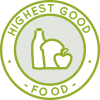 One Community is developing sustainable and free-shared ecology through Highest Good food that is more diverse, more nutritious, locally grown and sustainable, and part of our open source botanical garden model to support and share bio-diversity:
One Community is developing sustainable and free-shared ecology through Highest Good food that is more diverse, more nutritious, locally grown and sustainable, and part of our open source botanical garden model to support and share bio-diversity:
- Learn about these sustainable and free-shared ecology food structures: Hoop House Hub | Aquapini & Walipini Open Source Hub
- See what we’ll be growing: Gardens & Hoop Houses | Large-scale Structures | Food Forest | TA
This week, the core team continued updating and expanding the Highest Good Food tools, equipment, materials, and supplies document by adding new items, descriptions for each item and categorizing each item. Additionally, they collaborated with Hayley via phone call to discuss item descriptions and the inclusion of relevant photos. Highest Good food is an important part of sustainable and free-shared ecology with One Community’s open source plans. See their work in the collage below.
Charles Gooley (Web Designer) continued to work on various recipes as part of the Transition Food Self-sufficiency Plan. He completed the task of organizing recipes and alphabetizing them within their respective pages. Subsequently, work began on generating tables of contents for the Vegan Rice, Vegan Miscellaneous, Vegan Pasta, and Vegan Potato recipe sections. Additional content for the recipe pages will be incorporated as it becomes available. Highest Good food is an important part of sustainable and free-shared ecology with One Community’s open source plans. See his work in the collage below.
Hayley Rosario (Sustainability Research Assistant) continued helping finalize the Highest Good Food rollout plan and focused on the integration program for small-scale organizations. She primarily rewrote, researched, and addressed minor issues in the documentation. Participating in the rewriting process, she expanded on the steps for implementing a food program into an organization. Additionally, she sourced links to support and elaborate on significant claims and ideas within the document. Hayley’s final task involved initiating the summary section to conclude the plan. Highest Good food is an important part of sustainable and free-shared ecology with One Community’s open source plans. See her work in the collage below.
HIGHEST GOOD EDUCATION PROGRESS
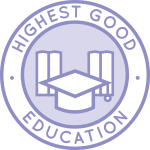 One Community is developing sustainable and free-shared ecology through Highest Good education that is for all ages, applicable in any environment, adaptable to individual needs, far exceeds traditional education standards, and more fun for both the teachers and the students. This component of One Community is about 95% complete with only the Open Source School Licensing and Ultimate Classroom construction and assembly details remaining to be finished. With over 8 years of work invested in the process, the sections below are all complete until we move onto the property and continue the development and open sourcing process with teachers and students – a development process that is built directly into the structure of the education program and everything else we’re creating too:
One Community is developing sustainable and free-shared ecology through Highest Good education that is for all ages, applicable in any environment, adaptable to individual needs, far exceeds traditional education standards, and more fun for both the teachers and the students. This component of One Community is about 95% complete with only the Open Source School Licensing and Ultimate Classroom construction and assembly details remaining to be finished. With over 8 years of work invested in the process, the sections below are all complete until we move onto the property and continue the development and open sourcing process with teachers and students – a development process that is built directly into the structure of the education program and everything else we’re creating too:
- Program Overview: Education Open Source Hub
- How the components work together as part of One Community’s sustainable and free-shared ecology education model: How to use the Education for Life Program
- Lesson Plans for Life – Lesson Plans How-to
- Foundations of Outstanding Leaders, Teachers, and Communicators
- Curriculum for Life
- Teaching Strategies for Life
- Learning Tools and Toys for Life
- Evaluation and Evolution
This week, Apoorv Pandey (Mechanical Engineer) continued helping with the engineering details for the The Ultimate Classroom part of the Highest Good Education component. He focused on optimizing drain pipes and addressing potential plumbing concerns in a straw bale construction context. Furthermore, he reassessed the project goals, acknowledged the necessity for additional preparation time and studied about AutoCAD tutorials to enhance his proficiency in handling title blocks according to the California Construction format. The One Community model of combining forward-thinking education with sustainably built classrooms like this are an excellent example of sustainable and free-shared ecology. See the collage below for his work.
HIGHEST GOOD SOCIETY PROGRESS
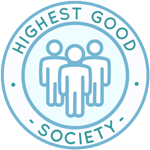 One Community is developing sustainable and free-shared ecology through a Highest Good society approach to living that is founded on fulfilled living, the study of meeting human needs, Community, and making a difference in the world:
One Community is developing sustainable and free-shared ecology through a Highest Good society approach to living that is founded on fulfilled living, the study of meeting human needs, Community, and making a difference in the world:
- Read the Highest Good society overview: Highest Good Society
- Learn about the model for fulfilled living and sharing: A Day in the Life
- Learn about the 4 economic models: RBE | For-profit | Non-profit | Entrepreneurship
- Learn about our open source community collaboration and management software: The Highest Good Network
This week, the core team completed over 60 hours managing One Community volunteer-work review not included above, emails, social media accounts, web development, new bug identification and bug-fix integration for the Highest Good Network software, and interviewing and getting set up new volunteer team members. They also shot and incorporated the video above that talks about sustainable and free-shared ecology and how sustainable and free-shared ecology is a foundation of the bigger picture of everything One Community is doing. The pictures below shows some of this work.
Aaron Wang (Fundraising Assistant) continued his extensive research on connections with Robert Downey Jr., gathering emails, LinkedIn profiles, and background information of individuals who may know Downey. Additionally, Aaron focused on identifying candidates with investor backgrounds, further expanding his approach to building strategic partnerships within the philanthropic and investment communities. This effort aims to enhance his ability to connect with funders by fostering relationships with relevant parties involved in these networks. Fostering these relationships paves the way for One Community‘s goal for sustainable and free-shared ecology. The following images highlight his progress for the week.
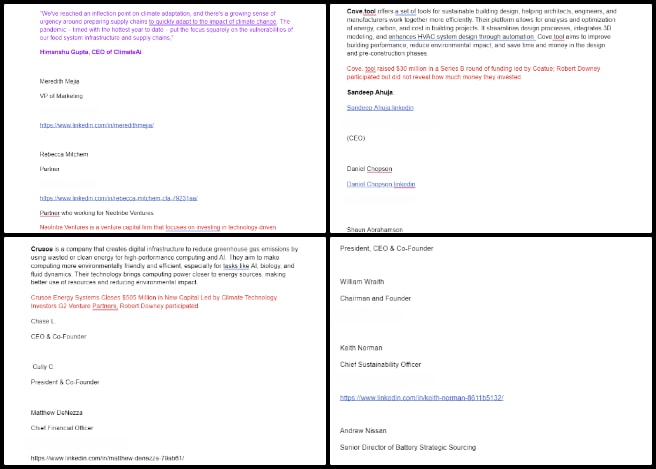
Arun Chandar Ganesan (Volunteer Data Analyst and SEO and Social Media Assistant) continued his work related to social media scheduling for Facebook and Instagram. This week he focused on checking and verifying the SEO work carried out on webpages, alongside addressing incomplete SEO tasks from previous efforts. He maintained the scheduling of social media posts and collaborated with Jae to generate content text for images. Additionally, he analyzed metrics to determine the most impactful images and text, and facilitated a team meeting to delegate posting responsibilities. Working on social media posts and studying the metrics helps One Community to improve their reach and spread their message about sustainable and free-shared ecology. The following images show his work for the week.
Faisal Rasheed (Graphic Designer) made suggested changes to previous graphics to enhance clarity and ensure clear visualization. This week he remade the “Large Group Consensus Governance Threshold Calculator” using Microsoft Excel and made adjustments in the existing graphic as per instructions. Additionally, he updated the “Image Integration and Documentation Instructions” file and created a new file for the “final review and approval of the graphics.” Moreover, he redesigned a graphic titled “HOW ENERGY FOCUS LED LIGHTING IS SUSTAINABLE,” enhancing its appeal and usefulness. Working on these graphics contributes to One Community‘s vision for sustainable and free-shared ecology. The images below show his progress for the week.
Prashanth Gowri Shankar Uppudi (Admin and Project Manager) continued work on the user manual, completing the Tasks and Timelog page section while progressing with other sections. He updated the document with the owner and volunteer perspectives, including relevant screenshots, and added to the shared folder. He also revised previous tasks that had overlooked the development account. Feedback has been received and corrective actions are being implemented. The entire menu bar section of the manual is nearing completion. Developing the HGN software user manual can help future members to work towards One Community‘s goal for sustainable and free-shared ecology. These images show the progress made this week.
ADMINISTRATION TEAM
The Administration Team’s summary, covering their work administrating and managing most of One Community’s ongoing processes for sustainable and free-shared ecology was managed by Vriddhi Misra (Admin and Marketing Assistant) and includes Durgeshwari Naikwade (Data Analyst), Jessica Fairbanks (Administrative Assistant), Jim Zhang (Administrative Assistant), Meenakshi Velayutham (Sustainability Associate), Olawunmi “Ola” Ijisesan (Administrative and Management Support), Rachna Malav (Data Analyst), Ram Shrivatsav (Data Analyst and Admin assistant), Ratna Meena Shivakumar (Data Analyst and Admin), Ruiqi Liu (Administrative Assistant), Sneka Vetriappan (Data Analyst), T R Samarth Urs (Data Analyst), Vibhav Chimatapu (Data Analyst/Admin Assistant), Xiaolai Li (Administrative Assistant), and Zuqi Li (Administrative Assistant and Economic Analyst). This week, Durgeshwari advanced her work on HR metrics analytics by generating a new dummy dataset and designing a mockup dashboard for ‘volunteer stats’, alongside compiling a Google document detailing the project’s steps, which she distributed to the team. She organized interviews and offered guidance to new volunteers through constructive feedback. Jessica reviewed Sajal’s volunteer ad postings, drafting them on Volunteer Match, alongside her regular administrative duties. She edited Sajal’s ads, uploaded them as drafts for Jae’s review, and initiated a review of the WBS details on Sajal’s page and the Hiring Team page. Jim met with Jae to identify his responsibilities as an administrative assistant, focusing on earthbag electrical cost analysis and past blogs SEO. He began researching solar panels, inverters, mounting systems, and batteries, organizing their prices into a spreadsheet. Additionally, Jim optimized five blog pages, raising their scores to 93. Ola completed tasks involving the review of work done by the teams managing the PR team members, providing necessary feedback to managers, and commenting on PR team members’ work for accountability. She tracked members’ progress reports for accuracy and documentation and assisted with volunteers’ training feedback performance where needed. Rachna did her part helping with sustainable and free-shared ecology as she completed her administrative tasks and integrated the feedback she received into her work. She assisted the hiring team by interviewing two potential volunteers and documented her insights to support the hiring process and decision. Rachna optimized SEO pages, engaging in a long process of editing and refining to enhance SEO scores, awaiting further feedback for iterative improvements. Additionally, she reviewed initial training materials, including documents, video tutorials, and relevant resources, compiling a list of recommendations to streamline future volunteer onboarding processes. Ram spent time working on making modifications to the SEO articles assigned. There was additional feedback he received from the admin team, that he worked on to make sure the SEO articles were up to the mark. He also worked on providing feedback in the training process of new members to the team to help their onboarding be smooth and seamless. He drafted his announcement and bio and signed up for working on scheduling social media posts for the month ahead. Ratna reviewed the weekly progress update #581 and prepared collages for the food, education, and core teams. Additionally, she reviewed other admins’ work as part of weekly progress updates. She scheduled and organized virtual interviews for candidates and managed the correspondence through email chains. Furthermore, she followed up with Ram, gave suggestions to Sneka and Rachna’s blogs and gave a final check for some of the already reviewed blogs. Ruiqi completed the four-step review process for the Dev Dynasty and Expresser Team, providing feedback to all team members and following up on their work. She created collage images for every team, stored them in Dropbox, and added the collages to the media library on WordPress. Ruiqi also utilized weekly summaries to generate SEO keywords and incorporated them as Alt Titles. She helped with the new admin’s training work. She also engaged in Search Engine Optimization and analytics. She followed the checklist table revised blogs 280-289, and 304-309. In addition, Ruiqi also integrated Meena’s comment in the Food infrastructure spreadsheet. Sneka focused on OC Administration tasks, primarily revolving around SEO page editing and management. She reviewed and optimized SEO pages, incorporating feedback from previous iterations. She spent time managing timelogs, providing feedback, and assisting in the training process for new team members. She also worked on webpage maintenance, including adding weekly summaries and collages to webpages. Samarth managed the PR review team assigned to him. He reviewed their work and provided necessary feedback. Samarth made changes to blog posts for SEO optimization based on the feedback he received. Vibhav carried on his administrative duties by reviewing the PR Team’s work, which involved proofreading their weekly summaries, ensuring the submission of the required number of PRs, and providing feedback on their Google Docs. He also created group summaries and collages for the team to insert into his WordPress page. He continued on-webpage SEO optimization, achieving notable results. Blogs were enhanced, with their scores boosted to 90+ through various optimization techniques. This included strategically incorporating focus keywords to improve keyword density ratios and optimizing titles by adding impactful power words and numbers. Vriddhi did her part helping with sustainable and free-shared ecology as she focused on optimizing blogs by assigning new tasks to the team and reviewing blog posts. She spent time reviewing and reassigning blogs, ensuring they were appropriately distributed. She worked on reassigning blog posts to One Community’s Jae editor account, followed by reviewing edits. She worked on the Blog for Week #581, compiling summaries for the admin team and creating collages. Vriddhi also started working towards the Week #582 blog. Xiaolai organized documents, edited summaries, and completed the weekly report 581. He assisted with training new employees and evaluated their progress. Additionally, he contributed to the training process and reviewed the solar energy project. Xiaolai also organized documents, edited summaries, and set up a webpage for the weekly report. Zuqi organized a weekly summary for the Graphic Design Team and updated the weekly blog to appreciate the team’s contribution. She reviewed 2 admins’ weekly updates and provided feedback for necessary adjustments. Zuqi also provided guidance and feedback on new admins’ initial setup process and helped to review their action items. One Community’s model for sustainable and free-shared ecology includes developing and maintaining a huge administration team like this. You can see the work for the team in the image below.
GRAPHIC DESIGN TEAM
The Graphic Design Team’s summary was managed by Zuqi Li (Administrative Assistant and Economic Analyst) and included Ashlesha Navale (Graphic Designer), Britney Robles (Graphic Designer), Jasmine Soria (Graphic Designer), Nancy Mónchez (Graphic Designer), Shayan Afkari (Graphic Designer) and Zixi Zhang (Graphic Designer), covering their work on graphic designs for sustainable and free-shared ecology. Ashlesha worked on creating twenty-seven recipe images – Master Recipe SWF, Master Recipe FWE, and Master Recipe FWF for the new Graphic Design Task – Recipe Images for Site Task. She also researched and curated a collection of nature-based background images and different theme-based images for creating Social Media Images, and updated the volunteer Announcement image on the web. Britney brainstormed new phrases containing rhetorical questions to augment the One Community list for utilization in social media images, created an illustrated rendition of one of the villages for social media use, and continued making more images using images and illustration. Jasmine did her part helping with sustainable and free-shared ecology as she focused on creating graphics, completing one, and finalizing revisions for uploads, learned the format for website pages, ensured correct formatting during the upload process, and engaged with SEO projects. Nancy revamped social media posts with a more serious tone to establish equilibrium across publication weeks, strategized to incorporate creative, serious, and corporate themes into the brand’s online presence, optimizing the brand’s digital communication strategy for enhanced engagement. Shayan created more than six social images, incorporating various design techniques and reviewing past works of his team members in HGN, and rectified the words and links in the bio images on the website. Zixi utilized files from Google Docs to design ten social media images using Adobe Firefly, Photoshop, Illustrator, Pixabay, Adobe Stock generated photos, graphics, illustrations, and icons, and employed AdobeExpress for the fonts used in the text. See the Highest Good Society pages for more on how this contributes to sustainable and free-shared ecology. See the collage below to view some of their work.
HIGHEST GOOD NETWORK PROGRESS
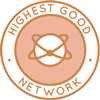 One Community is developing sustainable and free-shared ecology through open source Highest Good Network® software that is a web-based application for collaboration, time tracking, and objective data collection. The purpose of the Highest Good Network is to provide software for internal operations and external cooperation. It is being designed for global use in support of the different countries and communities replicating the One Community sustainable village models and related components.
One Community is developing sustainable and free-shared ecology through open source Highest Good Network® software that is a web-based application for collaboration, time tracking, and objective data collection. The purpose of the Highest Good Network is to provide software for internal operations and external cooperation. It is being designed for global use in support of the different countries and communities replicating the One Community sustainable village models and related components.
- Learn about this open source community collaboration and management software: The Highest Good Network
ALPHA SOFTWARE DEVELOPMENT TEAM
This week, the Alpha Team’s summary, covering their work on the Highest Good Network software was managed by Sucheta Mukherjee (Software Developer) and includes Anand Seshadri (Software Engineer), Gayathridevi Chithambaram (Full Stack Developer), Jordy Corporan (Software Engineer), and Lin Khant Htel (Frontend Software Developer). The Highest Good Network software is how we’ll manage and objectively measure our processes for sustainable and free-shared ecology across our social architecture, construction, production, and maintenance processes. This week, Sucheta focused on finalizing error handling within the project page filtering mechanism, specifically targeting filtering by user’s first and last name, and initiated a pull request (PR2244) to align with the development branch. Additionally, work was done on refining the Add_Task_modal formatting by transitioning away from inline styles to CSS classes for div and spans. Anand worked on the Dark Mode Modals change in the Reports page, applying the dark theme to various components including modal buttons, hover states, and tooltip modals, and implemented dark modes for specific buttons. Anand also addressed error color issues and extended dark themes across all modals on the Reports page, with plans to create a Pull Request for the completed work. Lin reviewed 10 pull requests and approved 7 on the HGN GitHub repository, while also writing unit tests for the dashboardController and planning to refine testing code following discussions with Diego. Additionally, Lin learned more about unit testing and integration testing. Jordy enhanced his proficiency in unit testing, particularly focusing on Jest while developing tests for the OwnerMessageController, and provided feedback on PRs #941 and #2241+PR#919, while finalizing unit tests for the ownerMessageController to ensure clean and well-structured code. Gayathridevi’s primary focus was on addressing design issues with the Projects/People/Teams page on narrow screens. She worked to enhance user experience by ensuring that search results are immediately visible without requiring users to scroll down. The solution involves making it more apparent to users when search results are generated. The approach includes accessing the Reports section, navigating to Projects/People/Teams, narrowing the screen, and typing any letter in the search bar. Importantly, these adjustments do not alter the functionality on larger screens. See the Highest Good Society and Highest Good Network pages for more on how this relates to sustainable and free-shared ecology. View some of the team’s work in the collage below.
BADGES BUGS SOFTWARE DEVELOPMENT TEAM
The Badges Bugs Team’s summary overseeing advancements in the Highest Good Network software was managed by Shaofeng Li (Software Engineer) and includes Summit Kaushal (Backend Software Developer), Xiao Zhang (Software Engineer), and Xiaohan Meng (Software Engineer). The Highest Good Network software is how we’ll be managing and objectively measuring our process for sustainable and free-shared ecology through our social architecture, construction, production, and maintenance processes. This week, Shaofeng worked on testing the ‘xhoursin1week’ badges in the ‘xhoursxweeks’ components of the HGN Software Development project, and participated in two weekly team meetings to address task reassignments. He also tackled issues with broken badge images, identifying causes and documenting findings to aid in troubleshooting. Summit worked on a collaboration document, addressing comments and completing tasks therein, while also reviewing and testing PRs 326, 665, and 929. Despite encountering issues with PR 929 in development, Summit made necessary adjustments and updated its description to ensure compatibility with frontend 2091, continuing efforts to diagnose and resolve the ongoing issues. Xiao did his part helping with sustainable and free-shared ecology as he took on additional responsibilities from a part-time teammate, testing all badges in the badge table for functionality and accuracy and addressing system issues to ensure compliance with required standards. His work included exploring Microsoft Azure features to prepare for a project aimed at removing duplicate badges, enhancing database management and maintaining badge data integrity. Xiaohan extended her testing to ‘X hours X week streak’ badges and others within Renan’s PR environment, modifying database data for tests and collaborating with Jae on fixing broken badge images. She also verified the operation of code for badge report notifications. See the Highest Good Society and Highest Good Network pages for more on how this relates to sustainable and free-shared ecology. View some of the team’s work in the collage below.
BINARY BRIGADE SOFTWARE DEVELOPMENT TEAM
The Binary Brigade Team’s summary overseeing advancements in the Highest Good Network software was managed by Tapan Pathak (Software Engineer) and includes Aaryaneil Nimbalkar (Software Developer) and Huijie Liu (Software Engineer). The Highest Good Network software is how we’ll be managing and objectively measuring our process for sustainable and free-shared ecology through our social architecture, construction, production, and maintenance processes. This week, Huijie focused on resolving the bug related to inconsistencies in the logged time between the timelog and profile pages. She tested previously implemented code changes and is currently implementing a solution, considering resetting the totalTangibleHrs field in the user profiles in the database. Additionally, Huijie is exploring an alternative approach by recalculating the total time directly from time entries on the profile page to address the issue. Tapan did his part helping with sustainable and free-shared ecology as he scheduled the weekly meeting, ensured necessary resources, and addressed fixing the timelogs tab, which reverted to the user instead of remaining on the person being viewed. Despite completing the code fixation, the issue continued during testing, leading Tapan to investigate a potential API call mishandling. He made progress in identifying an API bug, by checking the POST request payload’s formatting and reviewing the server-side code. After working on the API problem and conducting multiple tests locally with different accounts, Tapan resolved the bug. See the Highest Good Society and Highest Good Network pages for more on how this relates to sustainable and free-shared ecology. View some of the team’s work in the collage below.
BLUE STEEL SOFTWARE DEVELOPMENT TEAM
The Blue Steel Team’s summary, presenting their work on the Highest Good Network software was managed by Jingyi Jia (Software Engineer, Team Manager), and includes Bhuvan Dama (Full stack Developer), Imran Issa (Software Developer), and Xiao Wang (Software Engineer). The Highest Good Network software is how we’ll be managing and objectively measuring our process for sustainable and free-shared ecology through our social architecture, construction, production, and maintenance processes. This week, Bhuvan worked on various tasks within HGN Software Development. He was also involved in orientation and initial setup activities, which included completing his bio for a social media post and summarizing his work at One Community. He developed test coverage scenarios for the Date picker component in the Unit test for TableFilter.jsx. Bhuvan then reviewed edge cases for the ReportBlock.sx file and gathered similar cases for Reporthead.jsx files. Imran completed ongoing tasks and initiated new ones related to splitting blue square actions from the infringementAuthorizer permission. He managed both frontend and backend modifications, opening PRs for these changes and completing a review for a PR where his feedback was requested. He also followed up on previously opened PRs needing his attention. Jingyi did their part helping with sustainable and free-shared ecology as they completed the “readyForReview” permission feature, testing it to ensure functionality across various scenarios. This testing confirmed the feature’s robustness and seamless integration into the system, marking a key milestone in the project. Xiao provided technical assistance to his colleagues; he helped Jae with issues preventing the execution of the bluesquare assignment cron job and resolved a timer malfunction on the userprofile page. After reviewing a pull request by Nathan, Xiao identified and addressed a bug stemming from his earlier refactor. See the Highest Good Society and Highest Good Network pages for more on how this relates to sustainable and free-shared ecology. See below to view images of their work.
CODE CRAFTERS SOFTWARE DEVELOPMENT TEAM
The Code Crafters Team’s summary, covering their work on the Highest Good Network software, was managed by Anirudh Ghildiyal (Software Engineer) and includes Meet Padhiar (Software Engineer) and Weiyao Li (Software Engineer). The Highest Good Network software is how we’ll be managing and objectively measuring our process for sustainable and free-shared ecology through our social architecture, construction, production, and maintenance processes. This week, Meet focused on writing unit tests for the BadgeReport component, ensuring comprehensive coverage of all edge cases to verify proper rendering. Additionally, Meet conducted thorough PR reviews for PR 2169, PR 2191, PR 2202, PR 2203, PR 2227, and PR 2236. Meanwhile, Anirudh did his part helping with sustainable and free-shared ecology as he created a new user feature and familiarizing himself with the system design document for managing user permissions. He enhanced existing code to align with updated requirements, though he encountered testing issues that are currently under investigation. Weiyao worked on creating a new user feature and read the system design document for managing user permissions. He also spent time improving and updating the existing code to match these new requirements. See the Highest Good Society and Highest Good Network pages for more on how this relates to sustainable and free-shared ecology. The collage below shows some of this work.
DEV DYNASTY SOFTWARE DEVELOPMENT TEAM
The Dev Dynasty Team’s summary, covering their work on the Highest Good Network software, was managed by Nahiyan Ahmed (Full Stack Software Developer) and includes Harsh Bodgal (Software Engineer), and Mingqian Chen (Software Engineer). The Highest Good Network software is how we’ll create sustainable and free-shared ecology throughout our social architecture, construction, production, and maintenance processes. Harsh offered valuable insights and feedback on multiple High Priority Pull Requests, including #2221, #2224, #2233, #2236, #2214, #2238, #2241, #2242, #2243, #2244, and #2246. Mingqian did their part helping with sustainable and free-shared ecology as they worked on enhancing the delete function to ensure the complete removal of individuals from the system, addressing lingering references to deleted accounts within the application after deletion from HGN. She began testing with various accounts to identify and eliminate any remaining references to the deleted accounts. Nahiyan completed three PRs”PR 2236, PR 2238, and PR 2243″implementing dark mode on various models across different application pages. He also discovered a bug on the Team Locations page and notified the developer for a fix. See the Highest Good Society and Highest Good Network pages for more on how this relates to sustainable and free-shared ecology. The collage below shows some of this work.
EXPRESSERS SOFTWARE DEVELOPMENT TEAM
The Expressers Team’s summary, covering their work on the Highest Good Network software, was managed by Christy Guo (Software Engineer) and includes Shereen Punnassery (Full Stack Software Engineer), Mohammad Abbas (Software Engineer), and Tareq Mia (Software Engineer). The Highest Good Network software is how we’ll create sustainable and free-shared ecology throughout our social architecture, construction, production, and maintenance processes. Christy focused on enhancing the unit and integration tests for both the entry controller and team controller, investing time in reviewing documentation and developing test cases to ensure robust functionality. She also created follow-up pull requests aimed at updating unit tests and integration tests within the respective files. Mohammad completed the “Show Hours on Badge” task. Shereen did her part helping with sustainable and free-shared ecology as she tackled frontend and backend tasks related to the Purchase Equipment component, resolving issues with the backend controller function and addressing bugs associated with logging purchase records. Tareq initiated the resolution of a technical issue affecting the team locations map component’s styling, which impacted table headers and rows across the application. See the Highest Good Society and Highest Good Network pages for more on how this relates to sustainable and free-shared ecology. The collage below shows some of this work.
GIT-R-DONE SOFTWARE DEVELOPMENT TEAM
The Git-R-Done Team’s summary, covering their work on the Highest Good Network software was managed by Hiral Soni (Full Stack Developer) and includes Nidhi Galgali (Software Developer), Rhea Wu (Software Engineer), and Sushmitha Prathap (Software Developer). The Highest Good Network software is how we’ll be managing and objectively measuring our process for sustainable and free-shared ecology across our social architecture, construction, production, and maintenance processes. This week, Hiral concentrated on improving the report page of the project by implementing design updates and ensuring responsiveness across different screen sizes. Working on an existing branch, she refined the layout and functionality to enhance user experience. Meanwhile, Rhea focused on completing recently assigned tasks and then watching tutorials and studying relevant articles, transitioning to a new task involving Routing and Controllers for the Log Equipment form. Nidhi did her part helping with sustainable and free-shared ecology as she spent her time exploring alternative approaches to address the challenge of mocking the hasPermissions module. Additionally, Sushmitha enhanced the project controller by developing unit tests for several functions. Creating three unit tests for the deleteProject function and tests for the getAllProjects controller, she also worked on the postProject and getProjectById functions, ensuring initial stability with respective unit tests. However, during testing, she encountered a TypeError with the deleteProject function’s unit tests, and she is currently collaborating with various team members to expedite a resolution. See the Highest Good Society and Highest Good Network pages for more on how this relates to sustainable and free-shared ecology. See the collage below for the team’s work this week.
MOONFALL’S SOFTWARE DEVELOPMENT TEAM
Moonfall Team’s summary, covering their work on the Highest Good Network software, was managed by Lu Wang (Software Engineer) and includes Abdelmounaim “Abdel” Lallouache (Software Developer), Haoji Bian (Software Engineer), Jiadong Zhang (Software Engineer) and Malav Patel (Software developer). The Highest Good Network software is how we’ll be managing and objectively measuring our process for sustainable and free-shared ecology throughout our social architecture, construction, production, and maintenance processes. Abdelmounaim made changes to the blue square scheduler, updated the explanation modals, and ensured that owners and admins can schedule beyond the limits allowed for regular users. Haoji resolved conflicts in both frontend and backend, implementing optimizations for improved application responsiveness, and addressing a persistent bug in the profile page. Jiadong did their part helping with sustainable and free-shared ecology as they focused on enhancing the dashboard experience, addressing pull request feedback, refactoring APIs, and improving code resilience. Lu worked on debugging EditTaskModal and ImportTaskModal files, assisting with team management tasks, and providing feedback and training to teammates while contributing to the weekly summary and review process. Malav worked on tasks to fix bugs in DELETE_TIME_ENTRY_OTHERS feature and HGN software development, making additional changes to restrict volunteer permissions and completing testing. See the Highest Good Society and Highest Good Network pages for more on how this relates to sustainable and free-shared ecology. Look below for a collage of their work.
REACTONAUTS’ SOFTWARE DEVELOPMENT TEAM
Reactonauts’ Team’s summary, covering their work on the Highest Good Network software, was managed by Masasa Thapelo (Software Engineer) and includes Changhao Li (Software Engineer), Dhairya Mehta (Software Engineer), Hetvi Patel (Full stack Developer), Hoang Pham (Software Developer), Peterson Rodrigues (Full-Stack MERN Stack Developer), Shengwei Peng (Software Engineer) and Shiwani Rajagopalan (Software Engineer). The Highest Good Network software is how we’ll be managing and objectively measuring our process for sustainable and free-shared ecology throughout our social architecture, construction, production, and maintenance processes. Changhao worked on unit test development, addressing bugs preventing previous tests from running and reporting weekly progress to the team manager. Dhairya focused on addressing the “Fix Projects find user function” task. He identified the root cause of the issue impeding user discovery within the projects section and took steps to develop a sort and search function aimed at optimizing user assignment processes. Hetvi resolved a bug in htmlContentSanitizer.js and developed test cases for the getWeeklySummaries method, listing scenarios and completing permission test case development. Hoang improved the dashboard view for other users, enabling Admin/Owner users to submit tangible time entries on behalf of others and updating the header to reflect user-specific navigation items, ensuring an accurate representation of user experiences while maintaining role-based access control integrity. Masasa did his part helping with sustainable and free-shared ecology as he solved the problem of the scrollbar in the user management page. Peterson opened a pull request to resolve the bug causing a blank screen when accessing the user profile page. Shengwei completed research and implemented self-hosting for TinyMCE, integrating it into the application and updating scripts and dependencies. Shiwani enhanced BMLogin and TeamMemberTasks unit tests, refining validation error handling and crafting 12 distinct test cases. See the Highest Good Society and Highest Good Network pages for more on how this relates to sustainable and free-shared ecology. Look below for pictures of this work.
SKYE’S SOFTWARE DEVELOPMENT TEAM
Skye’s summary, covering their work on the Highest Good Network software, was managed by Luis Arevalo (Front End Developer) and includes Abi Liu (Software Engineer), Bhuvaneswari Gnanasekar (Software Engineer), Clemar Nunes (Web Developer), Gowtham Dongari (Software Engineer), Jiarong Li (Software Engineer) and Yao Wang (Software Engineer). The Highest Good Network software is how we’ll be managing and objectively measuring our process for sustainable and free-shared ecology throughout our social architecture, construction, production, and maintenance processes. Abi focused on planning, researching, and designing components for the weekly volunteer summary page, collaborating with Jae and Durgeshwari to finalize designs and create a mockup using Looker. Abi also managed merge conflicts by rebasing feature branches with the development branch and completed reviews of PR 925 and 921. Bhuvaneswari worked on implementing the putRole functionality for enabling role assignment, focusing on understanding and configuring necessary permissions. Clemar developed a feature, implementing a system to display an informative modal when granting new permissions to users, along with finalizing previously requested implementations and making adjustments to ensure operational functionality. Gowtham did his part helping with sustainable and free-shared ecology as he enhanced the user interface and functionality within project components, adjusting the summary modal and aligning content uniformly while debugging and reviewing Reports component functionality. He also worked on formatting the Weekly Remaining Summaries submission page and reviewed PRs #928, #941, and #925, collaborating with Jiarong to address persistent issues in the bug reports component, aiming to enhance system reliability and user experience. Jiarong made columns editable by the Owner on the User Management Page. The work involved reading through the existing code in UserManagement.jsx, UserTableData.jsx, BasicInformationTab.jsx, and UserProfile.jsx to understand the frontend architecture. See the Highest Good Society and Highest Good Network pages for more on how this relates to sustainable and free-shared ecology. See the collage below for some of their work.
SOFTWARE PR REVIEW TEAM A-L
The PR Review Team’s summary for team members’ names starting with A-L and covering their work on the Highest Good Network software was managed by Vibhav Chimatapu (Data Analyst/Admin Assistant). The Highest Good Network software is a foundation of what we’ll be using to measure our results for sustainable and free-shared ecology. This week’s active members of this team were: Carl Bebli (Software Engineer), Carlos Gomez (Full-stack Software Developer), Ibrahim Al Balushi (Software Engineer), Jay Srinivasan (Software Engineer), KaiKane Lacno (Software Developer and Team Manager), Kaushik Malikireddy (Full-stack Developer Intern) and Kurtis Ivey (Software Engineer). They reviewed all the Highest Good Network PRs (Pull Requests) shared in this week’s update. Learn more about how the Highest Good Network will measure and assist in achieving sustainable and free-shared ecology in the Highest Good Network open source hub. The collage below shows a compilation of the work from this team.
SOFTWARE PR REVIEW TEAM M-Z
The PR Review Team’s summary for team members’ names starting with M-Z and covering their work on the Highest Good Network software was managed by Olawunmi Ijisesan (Administrative and Management Support) and Samarth Urs (Administrative Assistant and Data Analyst). The Highest Good Network software is a foundation of what we’ll be using to measure our results of sustainable and free-shared ecology. This week’s active members of this team were: Min Sun (Software Engineer), Nathalia Mesquita Carnevalli (Full-stack Software Developer), Nathan Hoffman (Software Engineer), Nishitha Shetty (Software Engineer), Olga Yudkin (Software Engineer), Ramakrishna Aruva (Software Engineer), Ramya Ramasamy (Full Stack Developer), Shigeki Furukawa (Frontend Developer), Shivani Adusumilli (Software Engineer), Sichun Wang(Software Engineer), Tim Kent (Full Stack Software Engineer) and Zijie Yu (Software Engineer). They reviewed all the Highest Good Network PRs (Pull Requests) shared in this week’s update. Learn more about how the Highest Good Network will measure and assist in sustainable and free-shared ecology in the Highest Good Network open source hub. The collage below shows a compilation of the work from this team.
AND WE PRODUCED THIS WEEKLY UPDATES BLOG – CLICK HERE TO SUBSCRIBE
FOLLOW ONE COMMUNITY’S PROGRESS (click icons for our pages)
INVESTOR PAGES
GET INVOLVED
DONATE | WAYS ANYONE CAN HELP | MEMBERSHIP
CLICK HERE FOR ALL PAST UPDATES
 One Community
One Community